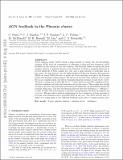AGN feedback in the Phoenix cluster
Author(s)
Pinto, C; Bambic, CJ; Sanders, JS; Fabian, AC; McDonald, M; Russell, HR; Liu, H; Reynolds, CS; ... Show more Show less
DownloadAccepted version (1.012Mb)
Terms of use
Metadata
Show full item recordAbstract
© 2018 The Author(s). Active galactic nuclei (AGNs) release a huge amount of energy into the intracluster medium, with the consequence of offsetting cooling and star formation (AGN feedback) in the centres of cool-core clusters. The Phoenix cluster is among the most massive clusters of galaxies known in the Universe. It hosts a powerful starburst of several hundreds of solar masses per year and a large amount of molecular gas in the centre. In this work we use the high-resolution Reflection Grating Spectrometer (RGS) onboard XMM-Newton to study the X-ray-emitting cool gas in the Phoenix cluster and the heating-cooling balance. We detect for the first time evidence of OVIII and Fe XXI-XXII emission lines, the latter demonstrating the presence of gas below 2 keV. We find a cooling rate of 350 ± 200250 M⊙ yr-1 below 2 keV (at the 90 per cent confidence level), which is consistent with the star formation rate in this object. This cooling rate is high enough to produce the molecular gas found in the filaments via instabilities during the buoyant rising time. The line broadening indicates that the turbulence (~300 km s-1 or less) is below the level required to produce and propagate the heat throughout the cool core. This provides a natural explanation for the coexistence of large amounts of cool gas, star formation, and a powerful AGN in the core. The AGN activity may be either at a young stage or in a different feedback mode, due to a high accretion rate.
Date issued
2018Department
MIT Kavli Institute for Astrophysics and Space ResearchJournal
Monthly Notices of the Royal Astronomical Society
Publisher
Oxford University Press (OUP)